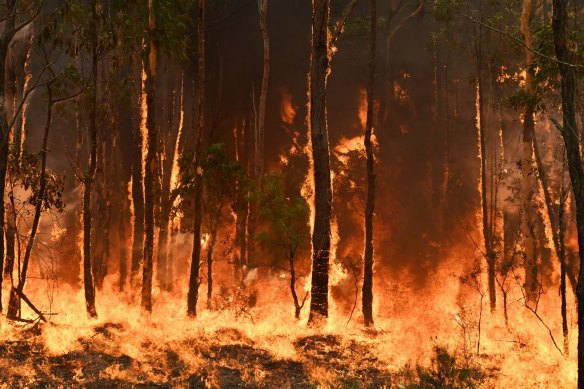BAL Report Principles: Important Info for Homeowner
BAL Report Principles: Important Info for Homeowner
Blog Article
Ensuring Shrub Fire Defense Through Correct BAL Record Evaluation
In the realm of bush fire security, the careful evaluation of Bushfire Attack Level (BAL) records stands as a cornerstone for securing residential or commercial properties against the devastating impact of wildfires. With environmental elements and residential or commercial property characteristics playing significant roles in figuring out the level of threat, a detailed understanding of BAL ratings becomes imperative.
Comprehending Bushfire Assault Degree (BAL)
In the realm of bushfire protection, comprehending the Bushfire Assault Level (BAL) is critical for guaranteeing reliable mitigation techniques. BAL is a system used to gauge the prospective risk a structure might deal with from a bushfire. It thinks about elements such as the type of plant life, the slope of the land, the Fire Threat Index, and the Fire Severity Index. Understanding the BAL rating of a residential property is important for home proprietors, policymakers, and building contractors to execute appropriate steps to guard versus bushfire hazards.

Value of BAL Report Evaluation
A necessary element in bushfire security planning includes the thorough analysis of BAL records to assess the possible dangers and figure out proper reduction approaches. BAL records supply critical information about the potential effect of bushfires on a residential or commercial property based upon numerous aspects such as plant life kind, range to prospective fire hazards, and incline of the land. Assessing these reports with accuracy is critical in developing efficient bushfire security steps customized to the specific danger profile of a home.
Implementing Fire Protection Steps
Applying efficient fire protection actions is important for securing residential properties in bushfire-prone locations. Among the main ways to enhance fire security is by creating defensible area around structures. This includes cleaning flammable greenery, such as dry leaves and branches, within a certain span of the residential property. Additionally, installing fire-resistant roof products can help in reducing the risk of cinders igniting the roof during a bushfire. Appropriately preserved seamless gutters and screens are additionally important to avoid particles accumulation that might fuel a fire.
Furthermore, having a adequate and well-maintained water, such as a tank or swimming pool, can help firefighters in their efforts to shield the building. It is necessary to have a clear evacuation plan in position and to make certain that all citizens are familiar with the procedures. In addition, having firefighting devices conveniently offered, such as tubes you can look here and fire extinguishers, can aid in taking on tiny area fires prior to they escalate. In general, applying a combination of these fire protection steps can significantly increase the chances of securing residential properties throughout bushfire occasions.
Mitigating Risks in Fire-Prone Areas
To strengthen residential properties versus bushfire threats, a calculated emphasis on mitigating dangers in fire-prone areas is critical. One essential element of danger reduction is maintaining defensible space around properties by removing combustible plants, making sure sufficient spacing between structures and trees, and utilizing fire-resistant landscaping techniques.
Additionally, creating or retrofitting structures with fireproof materials and making sure correct upkeep of roof coverings, rain gutters, and exterior cladding can significantly enhance the building's durability to bushfires. Developing and exercising a bushfire emergency situation plan with all residents, consisting of discharge treatments and interaction methods, is additionally essential in mitigating threats efficiently. By taking on a positive technique to take the chance of mitigation in fire-prone locations, homeowner can much better protect their assets and boost total bushfire preparedness.
Ensuring Home Safety And Security and Durability
Making certain the safety and security and resilience of properties in fire-prone locations needs an unwavering dedication to robust precautionary measures and tactical planning. Residential property safety starts with executing effective procedures to decrease fire dangers. This includes keeping a defensible space around the home by getting rid of flammable greenery, guaranteeing correct maintenance of roof coverings and rain gutters, and making use of fire-resistant structure products. Routine maintenance of firefighting equipment, such as tubes and automatic sprinkler, is additionally important to home durability.
Resilience, on the other hand, entails the capacity of a residential or commercial property to stand up to and recoup from a bushfire. By proactively attending to these aspects, building proprietors can much go to my blog better shield their properties and liked ones from the hazard of bushfires.
Conclusion
To conclude, making sure bushfire security via appropriate BAL report analysis is critical for comprehending the level of danger posed by bushfires and implementing needed fire security procedures. By reducing threats in fire-prone areas and guaranteeing residential or commercial property security and durability, neighborhoods and people can much better prepare for and react to bushfire events. It is critical to prioritize fire security procedures to safeguard lives and building in these high-risk atmospheres.
In the realm of bush fire protection, the careful analysis of Bushfire Attack Level (BAL) reports stands as a foundation for safeguarding residential or commercial properties against the damaging impact of wildfires (BAL Report). Understanding the BAL ranking of a home is important for home policymakers, contractors, and proprietors to execute suitable link actions to protect versus bushfire dangers

BAL records supply important details regarding the possible influence of bushfires on a residential or commercial property based on different aspects such as vegetation kind, range to possible fire threats, and slope of the land (BAL Report). Overall, applying a mix of these fire defense actions can significantly increase the opportunities of guarding properties during bushfire occasions
Report this page